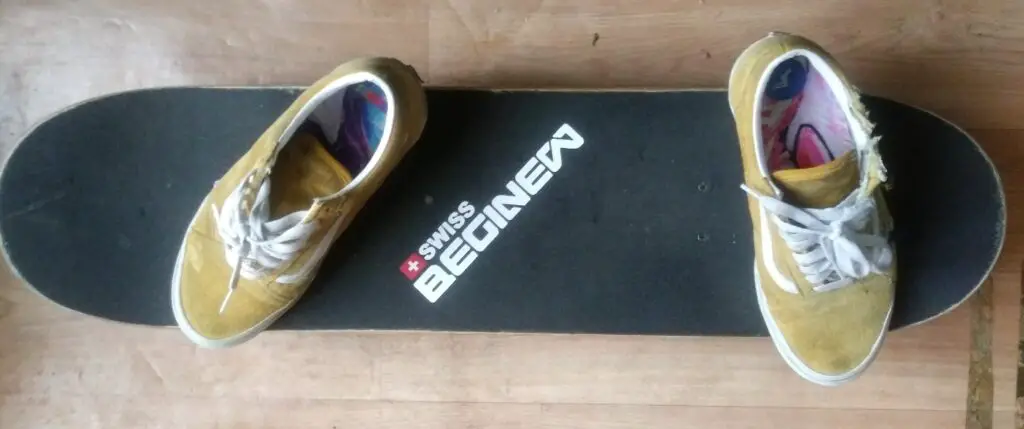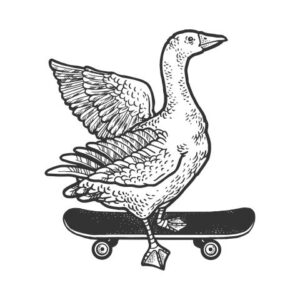If you are an absolute beginner, then you got to start somewhere. And that somewhere is learning to push while on your skateboard.
I remember when I was first skating in middle school. One day my mom came home from work and asked to step on my skateboard. Just to try it. Almost instantly, my skateboard flew out from under her.
If I wasn’t holding onto her, she would have slammed into the ground.
Anyway, if even standing on a skateboard is hard, then pushing is the next level up. So let’s go over the process assuming that you are an absolute beginner.
Let’s pretend that you’re my mom and you want to learn to push on a skateboard.
How to Push on Your Skateboard
1. Step Onto Your Board
Balancing on your board is hard for some people, but the key is to keep your feet at least shoulder-width apart and distribute your weight between both feet. This way your center of gravity is approximately over the center of the board and between your feet.
Step onto the board with your front foot first near the front bolts of the board. Then bring your back foot on near the back tail. Once your back foot is on the board, shift some of your weight so your weight isn’t all on one foot.
2. Center Your Front Foot
Now, before you push off there is something important to consider about your front foot. It needs to be balanced in the very middle of your front bolts. If your front foot is slightly to the left then you will turn to the left when you push and vice versa.
This is probably the most common reason why people fall or step off their board when pushing. You need to make sure that the force of your push will make your board go straight forward and not turn off to the side. This will take some practice to get a feel for so don’t worry too much if your early tries turn the board.
Also, keep in mind that your front foot will be facing so your toes are toward the nose of the board. This will help you push more naturally, and you will turn your front foot after the push has been completed.
3. Use Your Back Foot to Push Forward
Tilt your chest forward and bring your back foot down against the pavement while sweeping it back so you are pushed forward. The more force you give, the faster you will go.
It will take time to learn this motion smoothly so the best thing to do is get lots of practice. Try riding your skateboard around your city for a few hours each week. Some people mention that skating everywhere including convenience stores is a good way to practice. I personally don’t want to carry a skateboard everywhere at all times, but that’s an option too.
4. Bring Your Back Foot Onto the Board
After you have pushed off of the ground and are moving forward you can either push off one more time or bring your back foot onto your board again.
Pull your back foot back onto the tail of your board and shift some of your weight so that it is distributed between both feet again. Your center of gravity should be between your feet and centered above your moving board.
Your back foot should be roughly perpendicular to your board.
5. Turn Your Front Foot Perpendicular to The Board
Once your back foot is on the board again and you shifted your weight, you will notice that it will feel awkward to have the front foot face forward. Your body will want to naturally open up on the board.
It is at this time that you will turn your front foot about 90 degrees so that it is perpendicular to the board. This will give you better control of the board while moving. You will easily be able to lean forward and back to turn your board. You will also be in position to ollie and do other tricks.
Before you want to push again, you will turn your front foot so it is parallel to your board (pointing towards the nose of the board). Keep in mind that as you push, your front foot will keep switching positions from facing the nose of the board back to being perpendicular to the skateboard. It will take time to do this smoothly and naturally.
If you are wondering what protective gear is actually necessary while skating, then check out my full safety gear guide here before you go and just buy a helmet.
Skateboarding Pushing Styles
They’re really just a couple of pushing styles out there. Regular and goofy are the big two and which one you do is simply determined by your stance. Mongo pushing is something that people consider unnatural and awkward and I agree.
Let’s go over them.
Regular

Regular stance refers to having your left foot as your front foot and your right foot as your back foot. Your body will face to the right of your board as you ride.
This is considered the default stance and most people skate regular. It’s kind of like being right-handed. Pushing is done with your right foot.
Goofy

Goofy stance refers to having your right foot as your front foot and your left foot as your back foot. Your body will face to the left of your board as you ride.
This stance is less common, but still there are plenty of pros and skaters who skate goofy. One of my favorite skaters, Andy Anderson, skates goofy for instance.
Pushing is done with your left foot.
Mongo
Mongo doesn’t refer to which foot is in front or back, but refers to the front foot and how it doesn’t turn as you push.
When you push mongo, your front foot never turns from perpendicular to the board. This results in an awkward and unsightly pushing style. Some beginners will try this for simplicities sake, but it is a bad habit to learn and you should avoid it.
Mongo gets a lot of flak in the skating community. It isn’t well respected and usually is associated with people who have no idea how to actually skate.
Switch
Switch just refers to skating in your non-normal stance. So if you usually skate regular, then switch for you is skating goofy.
Pushing and skating switch is often very difficult for skaters who don’t actively ride switch. It is very good to learn because later on you will be doing 180 turn tricks and riding ramps. You will often find yourself riding switch.
Doing the switch version of a trick is considered a step up in difficulty. For instance, a switch ollie is more difficult than a normal ollie.
If you’re wondering how often you should skate to improve, check out my guide where skaters weigh in on how many times a week you should skate.
Additional Questions
How Do I Push My Skateboard Without Falling?
No one wants to fall while skateboarding. Luckily pushing off is relatively easy to learn and once you do learn how to push off, you likely won’t fall while pushing again.
Pushing your skateboard without falling will take lots of practice. The most common problem that beginners have while pushing their skateboard is not properly centering their front foot. If your front foot is not centered then your board will turn as you push and you will fall off or step off of your skateboard.
Keep in mind that understanding how to do something in skateboarding and actually training your body to do it are two different things. It takes time to build up strong muscle memory for a good skateboarding form. So practice, practice, and then practice some more.
Why Does My Front Pushing Foot Hurt?
Having foot pain while skating isn’t normal.
There are a number of reasons why your front foot hurts while skateboarding. The most likely reason is either your shoes don’t fit properly, you haven’t built up the muscles used in your front foot, or you have flat feet or low arches. Try and address each issue individually until the issue resolves itself. Your feet should not be in pain while skateboarding. If the problem persists, visit a doctor.
Try wearing a shoe size up from what you are wearing now. If that doesn’t work, get a skateboarding insole to help cushion some of the impact of skating. Lastly, just give it some time to build up muscle in your front foot. Start skating shorter sessions for a while and see if your foot gets stronger and the pain goes away.
Can I Push My Skateboard With My Front Foot?
I don’t think I have ever seen someone push their skateboard with their front foot other than as a joke.
Pushing a skateboard with your front foot is improper form and will make it difficult to control your skateboard. At higher speeds, this will also be quite dangerous. The front of the skateboard determines the direction of motion of the skateboard. If there is no foot controlling it, it can suddenly turn and cause the skater to crash into the ground.
I wouldn’t recommend actually trying to do this. There’s no good reason to even try and there are plenty of reasons why not to try this.
If you are ready to start learning how to ollie, first check out how long it takes to learn so you will know what to expect.
Additional Resources
Below is a great little video guide that goes over skateboarding as an adult and the different aspects. I linked it so that the video starts right when he goes over foot position and actually stepping on and pushing off with your board.
Honestly, I love how down-to-earth the guy is.
Conclusion
So that’s it.
Pushing off is one of the easiest things you can learn on a skateboard, but it is also critical to get down. Give yourself a couple of weeks of practice and you will be pushing off like a pro. I often take new skaters cruising with me and many people learn to push off in literally just an afternoon.
However, if it takes you more time than that, don’t be discouraged. Everyone learns at their own pace.
Anyway, I hope this guide helped you in some way. Thanks for reading, and look out for more content from Board and Wheels.



